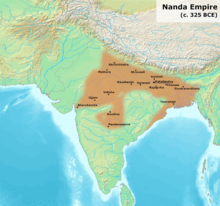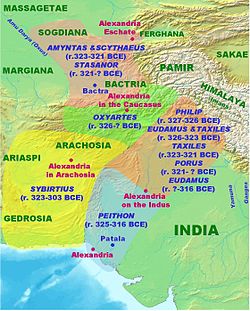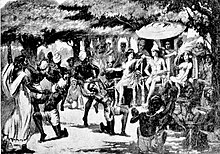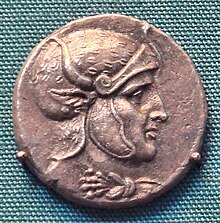Chandragupta Maurya
Chandragupta Maurya
|
|
[hide]This article has multiple issues. Please help improve it or discuss these issues on the talk page. (Learn how and when to remove these template messages)
|
| Chandragupta Maurya | |
|---|---|

Statue of Chandragupta Maurya, Laxminarayan Temple
|
|
| 1st Mauryan emperor | |
| Reign | c. 324 – c. 297 BCE[1] |
| Predecessor | Dhana Nanda of the Nanda Empire |
| Successor | Bindusara |
|
|
|
| Born | 340 BCE[citation needed] Pataliputra (now in Bihar)[citation needed] |
| Died | 297 BCE (aged 41–42)[1] Shravanabelagola, Karnataka[2] |
| Spouse | Durdhara and a daughter of Seleucus I Nicator |
| Issue | Bindusara |
| Dynasty | Maurya |
| Mother | Mura |
| Religion | Jainism |
| Maurya Emperors (322 BCE – 180 BCE) | |
| Chandragupta | (322–297 BCE) |
| Bindusara | (297–272/268 BCE) |
| Ashoka | (272/268–232 BCE) |
| Dasharatha | (232–224 BCE) |
| Samprati | (224–215 BCE) |
| Shalishuka | (215–202 BCE) |
| Devavarman | (202–195 BCE) |
| Shatadhanvan | (195–187 BCE) |
| Brihadratha | (187–180 BCE) |
| Pushyamitra (Shunga Empire) |
(180–149 BCE) |
Chandragupta Maurya (IAST: Candragupta Maurya, r. 321 – 297 BCE) was the founder of the Maurya Empire and the first emperor to unify north and south west of present-day India into one state. He ruled from 324 BCE until his voluntary retirement and abdication in favour of his son, Bindusara, in 297 BCE.[1][3][4]
Chandragupta Maurya was a pivotal figure in the history of India. Prior to his consolidation of power, most of the Indian subcontinent was divided into mahajanapadas, while the Nanda Empire dominated the Indo-Gangetic Plain.[5]Chandragupta succeeded in conquering and subjugating almost all of the Indian subcontinent by the end of his reign,[nb 1] except Tamil Nadu (Chera, Early Cholas and Early Pandyan Kingdom) and modern-day Odisha (Kalinga). His empire extended from Bengal in the east to Aria or Herat in the west (now called Afghanistan and Balochistan), to the Himalayas and Kashmir in the north, and to the Deccan Plateau in the south.[6] It was the largest empire yet seen in Indian history.[7][8]
In Greek and Latin accounts, Chandragupta is known as Sandrokottos and Androcottus.[9] He became well known in the Hellenistic world for conquering Alexander the Great's easternmost satrapies, and for defeating the most powerful of Alexander's successors, Seleucus I Nicator, in battle. By 323 BC he freed the piece of territory of India that was controlled by Seleuces, following Alexander's retreat.[6] Chandragupta subsequently married Seleucus' daughter to formalise an alliance and turning Nicator into a satrap, and established a policy of friendship with the Hellenistic kingdoms, which stimulated India's trade and contact with the western world.[citation needed] The Greek diplomat Megasthenes, who visited the Maurya capital Pataliputra, is an important source of Maurya history.
After unifying much of India, Chandragupta and his chief advisor Chanakya passed a series of major economic and political reforms. He established a strong central administration patterned after Chanakya's text on politics, the Arthashastra. Chandragupta's India was characterised by an efficient and highly organised bureaucratic structure with a large civil service. Due to its unified structure, the empire developed a strong economy, with internal and external trade thriving and agriculture flourishing. In both art and architecture, the Maurya Empire made important contributions, deriving some of its inspiration from the culture of the Achaemenid Empire and the Hellenistic world.[10] Chandragupta's reign was a time of great social and religious reform in India. Buddhism and Jainism became increasingly prominent. According to Jain accounts, Chandragupta abdicated his throne in favour of his son Bindusara, embraced Jainism, and followed Bhadrabahu and other monks to South India. He is said to have ended his life at Shravanabelagola (in present-day Karnataka) through Sallekhana.
Sources[edit]
The sources which describe the life of Chandragupta Maurya includes Jain, Buddhist, Brahmanical, Latin and Greek sources. Jain sources are Bhadrabahu's Kalpasutra and Hemachandra's Parisishtaparvan. Brahmanical sources are Puranas, Chanakya's Arthashastra, Vishakhadatta's Mudrarakshasa, Somadeva's Kathasaritsagara and Kshemendra's Brihatkathamanjari. Buddhist sources are Dipavamsa, Mahavamsa, Mahavamsa tika and Mahabodhivamsa.[11]
Early life[edit]
Very little is known about Chandragupta's youth and ancestry.[citation needed] What is known is gathered from later classical Sanskrit literature, as well as classical Greek and Latin sources which refer to Chandragupta by the names "Sandrokottos" or "Androcottus".[9][12]
Many Indian literary traditions connect him with the Nanda Dynasty in modern-day Bihar in eastern India.[citation needed] More than half a millennium later, the Sanskrit drama Mudrarakshasa calls him a "Nandanvaya", i.e. the descendant of Nanda.[13] Chandragupta was born into a family left destitute by the death of his father, chief of the migrant Mauryas, in a border fray.[14] Mudrarakshasa uses terms like kula-hina and Vrishala for Chandragupta's lineage.[15] According to Bharatendu Harishchandra's translation of the play, his father was the Nanda king Mahananda and his mother was a barber's wife named Mora, hence the surname Maurya.[16][non-primary source needed][17] This reinforces Justin's contention that Chandragupta had a humble origin.[18] On the other hand, the same play describes the Nandas as of Prathita-kula, i.e. illustrious, lineage.[18]
The Buddhist text, the Mahavamsa, calls Chandragupta a member of a division of the (Kshatriya) clan called the Moriya.[19][non-primary source needed][20] The Mahaparinibbana Sutta states that the Moriyas (Mauryas) belonged to the Kshatriya community of Pippalivana i.e. possibly Pipli on the outskirts of Kurukshetra.[20]These traditions indicate that Chandragupta came from a Kshatriya lineage. The Mahavamshatika connects him with the Shakya clan of the Buddha, a clan which also belongs to the race of Ādityas.[21][unreliable source?]
In Buddhist tradition, Chandragupta Maurya was a member of the Kshatriyas and that his son, Bindusara, and grandson, the famous Buddhist Ashoka, were of Kshatriya lineage, perhaps of the Sakya line. (The Sakya line of Kshatriyas is considered to be the lineage of Gautama Buddha, and Ashoka billed himself as "Buddhi Sakya" in one of his inscriptions.) [22][unreliable source?]
Puranas too depict Chandragupta from a Kshatriya lineage.[23]
Jain text Parisishtaparvan talks of Chandragupta's mother as a daughter of village chieftian who were rearers of royal peacocks.[20]
Plutarch reports that he met with Alexander the Great in Punjab,[24][25] and that he viewed the ruling Nanda Empire in a negative light:
According to this text, the encounter would have happened around 326 BCE,[26] suggesting a birth date for Chandragupta around 340 BCE.[citation needed] Plutarch and other Greco-Roman historians appreciated the gravity of Chandragupta Maurya's conquests.[citation needed] Justin describes the humble origins of Chandragupta, and explains how he later led a popular uprising against the Nanda king.[27]
Chandragupta completed his education in Taxila university.[28]
Foundation of the Maurya Empire[edit]
Chandragupta Maurya led a war of independence from Greek rule around 325 BC and achieved victory around 323 BC.[29]After that, he, along with Chanakya, gathered an army from Punjab and started invading Magadha on the frontiers.[30]
Nanda army[edit]
According to Plutarch, at the time of the Battle of the Hydaspes, the Nanda Empire's army numbered 200,000 infantry, 80,000 cavalry, 8,000 chariots, and 6,000 war elephants, which discouraged Alexander's men and prevented their further progress into India:
In order to defeat the powerful Nanda army, Chandragupta needed to raise a formidable army of his own.[31]
Conquest of the Nanda Empire[edit]
Chanakya had trained and guided Chandragupta and together they planned the destruction of Dhana Nanda. The Mudrarakshasa of Vishakhadatta as well as the Jain work Parishishtaparvan talk of Chandragupta's alliance with the Himalayan king Parvatka, sometimes identified with Porus.[32]
It is noted in the Chandraguptakatha that Chandragupta and Chanakya were initially rebuffed by the Nanda forces. Regardless, in the ensuing war, Chandragupta faced off against Bhadrasala, the commander of Dhana Nanda's armies.[33] He was eventually able to defeat Bhadrasala and Dhana Nanda in a series of battles, culminating in the siege of the capital city Pataliputra[27] and the conquest of the Nanda Empire around 322 BCE,[27] thus founding the powerful Maurya Empire in Northern India by the time he was about 20 years old.[citation needed]
Expansion[edit]
Conquest of Macedonian territories in India[edit]
After Alexander's death in 323 BCE, Chandragupta turned his attention to Northwestern South Asia (modern Pakistan), where he defeated the satrapies (described as "prefects" in classical Western sources) left in place by Alexander (according to Justin), and may have assassinated two of his governors, Nicanor and Philip.[4][27] The satrapies he fought may have included Eudemus, ruler in western Punjab until his departure in 317 BCE; and Peithon, ruler of the Greek colonies along the Indus River until his departure for Babylon in 316 BCE. The Roman historian Justin described how Sandrocottus (the Greek version of Chandragupta's name) conquered the northwest:
Conquest of Seleucus' eastern territories[edit]
Seleucus I Nicator, a Macedonian general of Alexander, who after Alexander's death, in 312 BCE, established the Seleucid Kingdom with capital Babylon, reconquered most of Alexander's former empire in Asia and put under his own authority the eastern territories as far as Bactria and the Indus (Appian, History of Rome, The Syrian Wars 55),[35] and in 305 BCE he entered into conflict with Chandragupta[36] (in Greek Sandrocottus):
The exact details of engagement are not known.[citation needed] As noted by scholars such as R. C. Majumdar and D. D. Kosambi, Seleucus appears to have fared poorly, having ceded large territories west of the Indus to Chandragupta. Due to his defeat, Seleucus surrendered Arachosia (modern Kandahar), Gedrosia (modern Balochistan), Paropamisadae (or Gandhara).[37][38][a]
Mainstream scholarship asserts that Chandragupta received vast territory west of the Indus, including the Hindu Kush, modern day Afghanistan, and the Balochistan province of Pakistan.[40][41] Archaeologically, concrete indications of Maurya rule, such as the inscriptions of the Edicts of Ashoka, are known as far as Kandhahar in southern Afghanistan.
Per Strabo, in Geography, Chandragupta married Seleucus's daughter to formalize the peace treaty.[42] In a return gesture, Chandragupta sent 500 war-elephants,[42][38][43][44][45] a military asset which would play a decisive role at the Battle of Ipsus in 301 BCE.[46] In addition to this treaty, Seleucus dispatched an ambassador, Megasthenes, to Chandragupta, and later Antiochos sent Deimakos to his son Bindusara, at the Maurya court at Pataliputra (modern Patna in Bihar state).[47] Later Ptolemy II Philadelphus, the ruler of Ptolemaic Egypt and contemporary of Ashoka the Great, is also recorded by Pliny the Elder as having sent an ambassador named Dionysius to the Maurya court.[47][48]
Classical sources have also recorded that following their treaty, Chandragupta and Seleucus exchanged presents, such as when Chandragupta sent various aphrodisiacs to Seleucus:[49]
Southern conquest[edit]
After annexing Seleucus' eastern Persian provinces, Chandragupta had a vast empire extending across the northern parts of Indian Sub-continent, from the Bay of Bengal to the Arabian Sea. Chandragupta then began expanding his empire further south beyond the barrier of the Vindhya Range and into the Deccan Plateau except the Tamil regions (Pandya, Chera, Chola and Satyaputra) and Kalinga (modern day Odisha).[27] The famous Tamil poet Mamulanar of the Sangam literature also described how the Deccan Plateau was invaded by the Maurya army.[1] By the time his conquests were complete, Chandragupta had succeeded in unifying most of Southern Asia including Malwa and Gujarat.[50]
The Maurya conquest of south is referred in Tamil works Ahananuru and Purananuru.[51]
Army[edit]
Megasthenes later[when?] recorded the size of Chandragupta's army as 400,000 soldiers, according to Strabo:
On the other hand, Pliny, who also drew from Megasthenes' work, gives even larger numbers of 600,000 infantry, 30,000 cavalry, and 9,000 war elephants:
Mudrarakshasa mentions that Chandragupta's army consisted of Sakas, Yavanas (Greeks), Kiratas, Kambojas, Parasikas and Bahlikas. Those opposing him included Chitravarma of Kuluta, Simhananda of Malaya, Pushkaraksha of Kashmira, Sindhusena of Saindhava and Meghakhya of Parasikas.[52]
Jainism and death[edit]
According to numerous Jain accounts such as those in Brihakathā kośa (931 CE) of Harishena, Bhadrabāhu charita (1450 CE) of Ratnanandi, Munivaṃsa bhyudaya (1680 CE) and Rajavali kathe, Chandragupta became an ardent follower of Jainism in his later years,[citation needed] renounced his throne, and followed Digambara monks led by Bhadrabahu to south India.[2] He is said to have lived as an ascetic at Shravanabelagola for several years before starving himself to death, as per Jain practice of sallekhana. These accounts are also supported by present-day names of local features near Shravanabelagola, and several inscriptions dating from 7th-15th century that refer to Bhadrabahu and Chandragupta in conjunction. Historians such as Vincent Smith and R. K. Mookerji consider the accounts unproven but plausible as they explain the sudden disappearance of Chandragupta from the throne at a young age.[53][54][55][56]
Regarding the inscriptions describing the relation of Bhadrabahu and Chandragupta Maurya, Radha Kumud Mookerji writes
The hill on which he practiced his penance is known as Chandragiri hill and a temple was built by him named Chandragupta basadi.[2]
Successors[edit]
After Chandragupta's renunciation, his son Bindusara succeeded as the Maurya Emperor. He maintained friendly relations with Greek governors in Asia and Egypt. Bindusara's son Ashoka became one of the most influential rulers in India's history due to his extension of the Empire to the entire Indian subcontinent as well as his role in the worldwide propagation of Buddhism.[citation needed]
In popular culture[edit]
- D L Roy Wrote a Drama named Chandragupta based on biography of Chandragupta.[citation needed]
- Chanakya's role in formation of the Maurya Empire is the essence of a historical/spiritual novel The Courtesan and the Sadhu by Dr. Mysore N. Prakash.[57]
- The story of Chanakya and Chandragupta was made into a film in Telugu Language in 1977 titled Chanakya Chandragupta. Akkineni Nageswara Rao played the role of Chanakya, while N. T. Rama Rao portrayed as Chandragupta.[58]
- The television series Chanakya is an account of the life and times of Chanakya, based on the play "Mudra Rakshasa" (The Signet Ring of "Rakshasa").[citation needed]
- In 2011, Chandragupt Maurya ,a television series was aired on Imagine TV.[59][60][61]
- The Indian Postal Service issued a commemorative postage stamp honoring Chandragupta Maurya in 2001.[62]
- In the American comic strip Pearls Before Swine a girl named "Carla" mentions the story of him becoming an ascetic, although she says monk, and starving to death.[63]
- Rajat Tokas is playing the character of Chandragupta Maurya in a historical fictional show Chandra Nandni.[citation needed]
See also[edit]
| Wikimedia Commons has media related to Chandragupta Maurya. |










